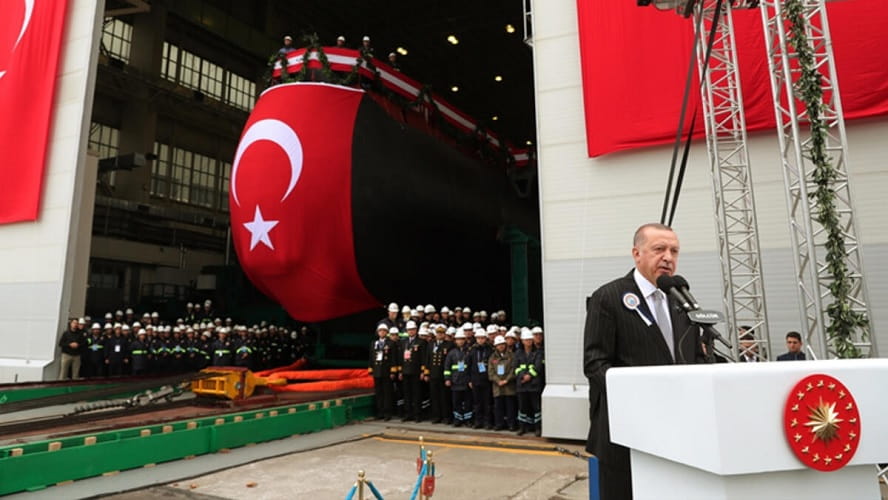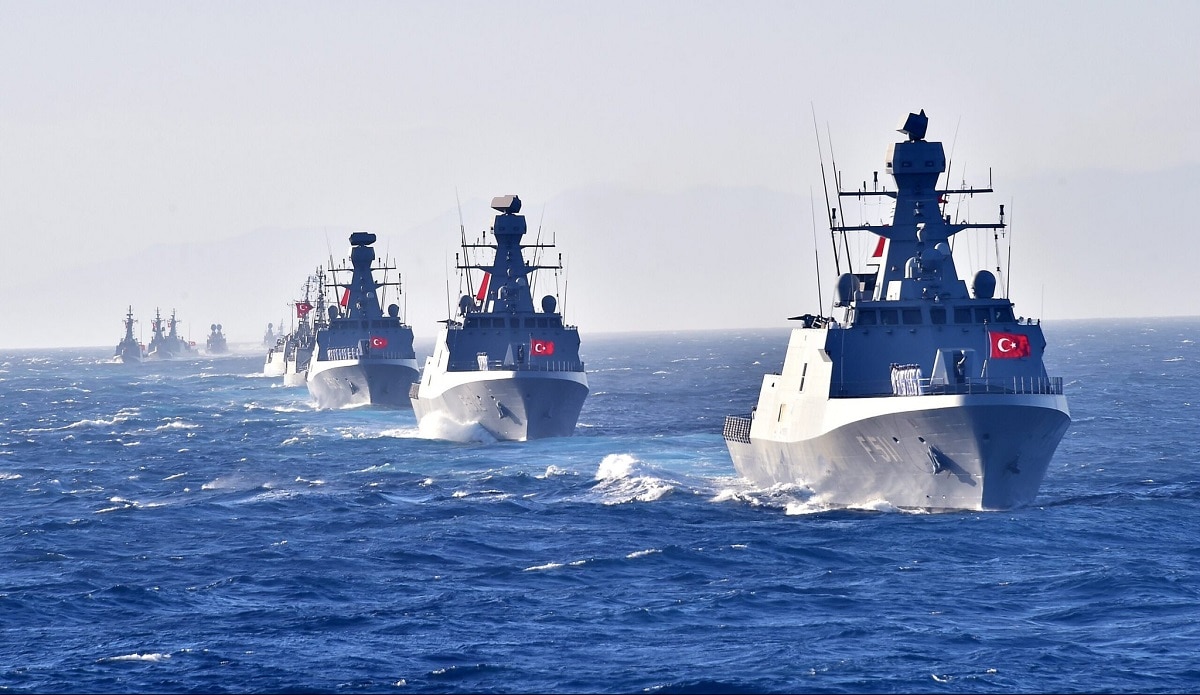Analysis: The Future Of The Turkish Navy

Turkish Navy picture
Analysis: The Future Of The Turkish Navy
The presence and visibility of the Turkish Naval Forces (Türk Deniz Kuvvetleri) have increased considerably within the Blue Homeland doctrine framework for several years. Regional disputes require Turkish naval forces to deploy more at sea. Thus, the Turkish defense industry's national policy has supported the continuously active Turkish Navy (TN), and a force composition is formed with indigenous weapons and systems.
Tayfun Ozberk 15 Feb 2021
The Turkish government is aware that an expanded, modernized fleet would add further muscle to the armed forces to protect its regional interests. Although there are so many parameters required to measure a navy’s strength, having substantial and technological assets is the first condition for building a navy’s future. Therefore, Turkey’s “indigenous move” aims to transform TN into one of the most remarkable naval powers worldwide. After the commissioning of Landing Helicopter Dock “Anadolu” TN is likely to form task groups and show presence at the open seas more than before. In addition, the Turkish President’s statement about the aircraft carrier project at the launching ceremony of the first domestic frigate “Istanbul” was a sign that the Turkish navy will be in the oceans in the future.
Currently, the backbone of the TN is the upgraded Gabya-class (Oliver Hazard Perry) frigates. In addition, the Barbaros-class frigates, which are newer and more technologically advanced, are also considered as critical assets. The TN operates in the surrounding seas with the largest submarine fleet of the Mediterranean, newly built Ada-class corvettes, and FACs.
As the Navy ages, Turkey plans to renew its fleet with indigenous efforts. After the CAATSA sanctions imposed by the U.S. because of Turkey’s S-400 air defense system purchase from Russia, indigenous solutions have become the most important of the few options. For this reason, the President of the Turkish Defence Industry promulgated last month that almost all of the main systems and weapons (including CIWS and VLS) of the I-class frigates will be developed by local companies. LHD Anadolu, Turkey’s largest warship ever, is scheduled to enter service for the TN this year. Although she will not carry F35B STOVL aircraft due to the sanctions imposed, she will significantly increase TN’s power projection capacity. The Anadolu will be able to transport a force the size of a minimum battalion without needing home base support. LHD Anadolu will meet the TN’s various needs — such as sustaining long-endurance, long-distance military combat, or humanitarian relief operations — while also acting as a command center and flagship for the Turkish Navy.
Ongoing projects that shape the future of the Turkish Navy

The Turkish Navy fleet by year-end. Image provided by
@miguyan2000
MILGEM project
The MILGEM (an abbreviation of “national ship”) project forms the basis for the renewal and strengthening of the Turkish Navy. Within the MILGEM project’s scope, 4 ADA-class corvettes were commissioned so far, and from the 5th ship, I-class frigates have started to be built. The
Istanbul frigate is expected to be commissioned in 2023, and the three sister ships will enter service for the TN by 2027. While I-class frigates will replace the Yavuz classes, Barbaros-class frigates will undergo
mid-life modernization and will be equipped with indigenous and modern sensors.
TF-2000 Air Defense Destroyer
TF-2000
The air defense needs of the TN’s task groups are met by Gabya-class frigates currently. As the replacement of Gabya-class frigates, four anti-air-warfare destroyers are planned to be commissioned within the scope of the TF-2000 project in the next decade. TF-2000 destroyers will be fitted with indigenous multifunctional CAFRAD AESA radar. The TF-2000 destroyers are expected to launch SIPER long-range air defense missiles which are still under-development.
Other surface combatants
Future Turkish Navy OPV
In addition to the frigates and destroyer projects, UFUK, a modern intelligence ship, will enter service this year. The Turkish Navy plans to commission two additional Bayraktar-class LST, and two offshore patrol vessels to protect its interests around EEZ. FAC-55 project will replace aged FACs within the next decade.
Support vessels
DIMDEG
Along with the combatants, TN plans to renew its logistics assets. Two medium-sized fuel tankers, whose construction has been completed, are expected to enter the fleet this year. Turkey intends to expand its logistics fleet with the large combat support ship DIMDEG by 2023. 16 Tuzla-class patrol boats, two large tugboats, and a submarine rescue ship called MOSHIP, which were completed and put into service, will serve for many years and contribute to the modern face of the TN.
Submarines
Reis-class submarine
The Turkish Navy will meet AIP (Air Independent Propulsion) technology with Type 214TN Reis-class submarines. The class’s lead submarine was launched last year, and six submarines are planned to be commissioned until 2027. It is expected that the Turkish Defense Industry, which cooperates with TKMS (Thyssenkrupp Marine Systems) for this project, will reflect the know-how experience gained from here to the indigenous submarine project called MILDEN. Locally developed torpedo “AKYA” and anti-ship missile “ATMACA” are expected to be launched from these submarines. According to many Turkey experts, MILDENs will be capable of launching indigenous “GEZGIN” cruise missiles, but there is no satisfactory explanation made by the officials yet.
Maritime Patrol Aircraft
MELTEM III MPA
Modernization of the Naval Aviation, a critical unit of the naval forces, continues with the Meltem project. Thales completed the command control systems and sensors modernization of the CN-235 maritime patrol aircraft (MPA), and the first ATR-72 (renamed as P-72) MPA was commissioned last year. A total of eight ATR-72 MPAs will enter service for the Turkish Naval Aviation as the last phase of the project.
UCAV
In addition to the Meltem project, the Turkish Naval Air Force will be equipped with unmanned systems. The breakthrough made by the Turkish defense industry in unmanned aerial vehicles provides more cost-effective reconnaissance and surveillance activities at sea. In addition to reconnaissance missions, Anka and TB-2 Bayraktar UCAVs can launch locally developed MAM-L laser-guided ammunition, UMTAS, and CİRİT missiles. These weapons can have devastating effects on the surface assets, which have weak air defense capabilities. TN plans to commission more than 20 UCAVs in the coming years.
MALE UAV
Aksungur, a Medium Altitude Long Endurance (MALE) class UAV System, is considered one of the most critical projects in strengthening the naval aviation force. It can perform day and night Intelligence, Surveillance and Reconnaissance (ISR), and strike missions with EO/IR, SAR, SIGINT payloads, and various air to ground weapons. Aksungur is expected to be used in anti-submarine warfare missions due to its high payload and sonobuoy carrying capacity, it is expected to launch lightweight torpedo in the following years. Turkish Aerospace Industries will start mass production of Aksungur this year.
USV
Turkey’s first UCSV ULAQ was
launched last week. The sea trials and missile test-fires are expected to be completed by half of the year. Later versions of ULAQ will be built according to the task it will perform. The version built for surface warfare will be capable to launch ATMACA anti-ship missiles, while ULAQ for ASW purposes can launch torpedoes.
Future policy
The current efforts to renew the fleet indicates that Turkey wants to be stronger in the sea. While establishing an effective A2/AD in the surrounding seas with its development trend in unmanned technology, it wants to be effective in areas far from the mainland with the LHD and aircraft carrier projects. Supporting the counter-piracy efforts in the Gulf of Aden since 2008 and touring the African continent with a task group formed in 2014 was the first sign that the Turkish Navy wanted to be in the oceans, which was the primary motivation for the ship and missile projects to build future naval forces. Thus, while the TN assets contribute multinational efforts such as CTF-151 in Africa, SNMG2, and UNIFIL in the Mediterranean, they participate in exercises carried out overseas as well.
In addition to its support for the activities carried out by NATO for decades, the TN wants to take more responsibilities and assume critical roles in NATO. Thus, Turkey initiated efforts to form the Turkish High Readiness Maritime Task Force (TURMARFOR) in July 2018 with the Turkish General Staff’s approval and tested this force’s operational capability in a “Dogu Akdeniz-2019”. TURMARFOR was established in the Aksaz Naval Base; after LHD Anadolu is commissioned, which is declared to NATO for this purpose, she will be the main asset of TURMARFOR. Turkey is the fifth country of NATO assumes a high-readiness task group role.
With the Turkish Defense Industry’s GENESIS ADVENT combat management system, the network-centric warfare applications at sea have begun. After coupling with other assets of the Turkish Armed Forces (TAF) via the “Kement” project, TN assets will be capable of conducting operations under the network of TAF. To sum up, the Turkish Naval Forces are taking steps accordingly to have an operational fleet that is effective in the open seas in the future, undertakes important roles in NATO, and fulfills the requirements of modern naval warfare. With the contemporary force composition, TN aims to be among the most effective navies globally and take part in all kinds of projects that will help keep the peace all over the world.
The presence and visibility of the Turkish Naval Forces have increased considerably within the Blue Homeland doctrine framework for several years...

www.navalnews.com




















